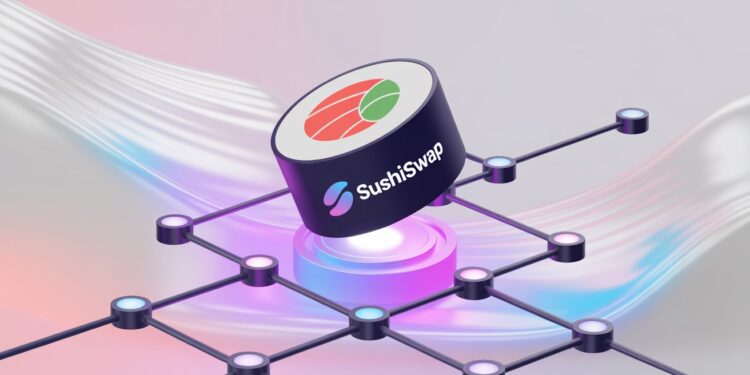The world of decentralized finance (DeFi) has grown exponentially over the last few years, with innovative platforms offering new ways to trade, earn, and invest. One such platform that has made waves in the DeFi community is SushiSwap. SushiSwap is a decentralized exchange (DEX) that allows users to trade, stake, and earn rewards through liquidity provision, all without relying on traditional centralized intermediaries. This platform has become a favorite in the crypto ecosystem due to its community-driven ethos, wide range of DeFi offerings, and governance model.
In this blog, we will dive deep into what SushiSwap is, how it works, and why it has gained popularity within the DeFi space. Whether you are new to cryptocurrency or an experienced DeFi participant, understanding SushiSwap could open new opportunities for you to engage in the world of decentralized finance.
What is SushiSwap?
SushiSwap is a decentralized exchange (DEX) built on the Ethereum blockchain. It was created as a fork of Uniswap, another leading decentralized exchange, with the goal of offering an alternative with additional features and a more community-focused governance model. SushiSwap allows users to swap tokens directly with one another without the need for intermediaries like centralized exchanges (CEXs), making it a trustless and decentralized platform.
The key selling points of SushiSwap are its liquidity pools, yield farming, and governance mechanisms, all designed to allow participants to earn rewards, vote on platform changes, and interact with the DeFi ecosystem in a decentralized manner.
What makes SushiSwap particularly unique is its community-driven approach. SushiSwap aims to involve users in its decision-making process through its Sushi governance token (SUSHI). This gives token holders a voice in the platform’s future development and ensures that changes to the protocol are made with the interests of the community in mind.
Key Features of SushiSwap
1. Decentralized Exchange (DEX)
SushiSwap, like other decentralized exchanges, enables users to trade cryptocurrencies without relying on centralized exchanges. On a DEX, users retain control of their private keys and funds, which are never stored on the platform. Instead, trades are facilitated through smart contracts, ensuring transparency and security.
Through liquidity pools on SushiSwap, users can provide liquidity by depositing pairs of tokens into the pool. In return, they earn fees generated by the platform based on the trades made by others. These fees are distributed among liquidity providers, giving them an incentive to contribute to the liquidity of the platform.
2. Liquidity Pools and Automated Market Maker (AMM)
At the heart of SushiSwap’s operation is the Automated Market Maker (AMM). This is a system where prices are determined algorithmically based on the supply and demand of assets in liquidity pools. Unlike order-book-based exchanges where buyers and sellers match orders, AMMs use liquidity pools to ensure that users can always swap tokens regardless of the order book’s state.
A liquidity pool consists of two or more tokens, where users can deposit an equal value of each token to provide liquidity. In return, liquidity providers (LPs) receive a proportional share of the transaction fees generated by trades on the platform. SushiSwap uses the constant product formula, the same model used by Uniswap, to ensure liquidity at any price point.
For example, if a user provides equal amounts of Ethereum (ETH) and SushiSwap’s native token (SUSHI) to a liquidity pool, the platform will reward them with a share of the fees generated when other users trade tokens within that pool.
3. Yield Farming and Staking
SushiSwap is also known for its yield farming features, which allow users to earn additional rewards by participating in liquidity provision and staking.
Users can stake their liquidity provider (LP) tokens—tokens they receive for adding liquidity to the pools—into SushiSwap’s Onsen program. This allows LPs to earn extra rewards in the form of SUSHI tokens. The more liquidity a user provides, the more they can earn, creating a compounding effect.
By staking their tokens, users also help secure the platform and enable efficient trading. This model of incentivizing liquidity providers is a key aspect of SushiSwap’s design, enabling both the growth of liquidity pools and user engagement.
4. Sushi Governance Token (SUSHI)
The SUSHI token plays an integral role in the governance and economic model of SushiSwap. Initially launched as a token for liquidity mining and rewards, SUSHI has since evolved into a governance token, allowing holders to participate in key decisions related to the protocol’s future. Token holders can vote on proposals, adjustments to the platform’s fee structure, new features, and more.
SUSHI holders are also rewarded with a portion of the platform’s transaction fees. The longer users hold their SUSHI tokens, the more they can participate in governance decisions, shaping the platform’s direction over time.
How Does SushiSwap Work?
SushiSwap operates based on several core principles and mechanisms that work together to create a seamless decentralized exchange experience. Here is a breakdown of how it works:
1. Creating Liquidity Pools
For SushiSwap to function effectively, it needs liquidity. Liquidity pools are created by users who deposit two different tokens into a pool in equal amounts. These pools are used for token swaps, and the tokens deposited by liquidity providers (LPs) are utilized to facilitate trades.
Liquidity pools on SushiSwap can be used to trade any pair of supported tokens, such as ETH/SUSHI, USDC/DAI, and many others. Once tokens are added to a pool, LPs are issued LP tokens which represent their share in the pool. These LP tokens can be used to withdraw the liquidity they provided, along with a portion of the transaction fees.
2. Token Swaps and Fees
When users swap tokens on SushiSwap, they are interacting with the liquidity pools. The price of a token swap is determined by the liquidity and ratios of the tokens in the pool. Each trade generates a fee (usually 0.3%) that is distributed to the liquidity providers in proportion to their share of the pool.
For example, if someone wants to trade ETH for USDC, they would pay a fee to the liquidity pool. The liquidity providers who contributed ETH and USDC to the pool receive these fees as a reward for providing liquidity.
3. SushiSwap Yield Farming and Staking
In addition to earning transaction fees from liquidity provision, users can also earn rewards by staking their LP tokens in SushiSwap’s Onsen program. This is SushiSwap’s version of yield farming, where users stake their LP tokens to earn SUSHI tokens as rewards. By participating in yield farming, users can amplify their earnings through rewards in the form of SUSHI, the platform’s native governance token.
4. SushiSwap Governance
One of the standout features of SushiSwap is its decentralized governance model. SushiSwap is governed by its community of users who hold the SUSHI token. These token holders can propose and vote on changes to the protocol, such as fee adjustments, the addition of new tokens to liquidity pools, or upgrades to the platform’s features.
The SushiSwap governance mechanism ensures that decisions are made collectively, and no central authority controls the platform. This allows the protocol to be more transparent and aligned with the interests of the community, rather than the interests of a small group of stakeholders.
Benefits of Using SushiSwap
1. Decentralization and Security
SushiSwap, like other decentralized exchanges, operates without a central authority, meaning users retain full control of their funds at all times. The platform is powered by smart contracts, which are publicly available for audit and review. This gives users the confidence that their funds are secure, and trades are executed in a trustless, transparent environment.
2. Community Governance
SushiSwap’s governance model allows users to vote on proposals and influence the future direction of the platform. This decentralized approach ensures that the community has a say in how the platform evolves, fostering innovation and transparency.
3. Yield Farming and Rewards
Liquidity providers on SushiSwap have the opportunity to earn a portion of the trading fees, as well as rewards through yield farming. This makes SushiSwap an attractive option for users looking to earn passive income by providing liquidity or staking their assets.
4. Cross-Chain Compatibility
SushiSwap is not limited to just the Ethereum network. The platform is expanding its ecosystem to support multiple blockchains, including Binance Smart Chain (BSC), Polygon, Fantom, and others. This cross-chain functionality ensures that users can trade on SushiSwap without being limited to a specific blockchain, making it more versatile and accessible.
Conclusion
SushiSwap has established itself as a leading player in the decentralized finance (DeFi) space by providing a robust decentralized exchange that offers users a chance to trade, provide liquidity, and earn rewards. Its community governance model, coupled with its focus on incentivizing liquidity providers, has made it one of the most popular DEX platforms in the world.
By offering additional features like yield farming, staking, and cross-chain compatibility, SushiSwap has proven to be more than just a traditional decentralized exchange. It is a powerful tool for DeFi enthusiasts and a cornerstone of the broader cryptocurrency ecosystem.
Whether you’re looking to trade cryptocurrencies, earn passive income, or participate in governance decisions, SushiSwap presents numerous opportunities for users to engage with the decentralized finance world in a way that is both secure and rewarding.
Join Us : Twitter | Website | GitHub | Telegram | Facebook | YouTube

























